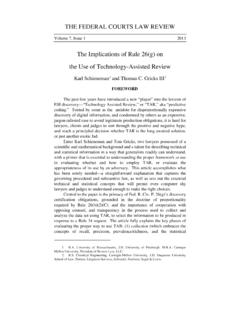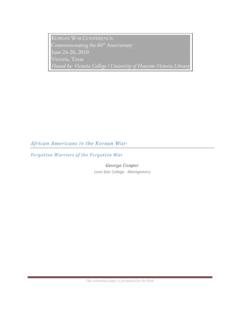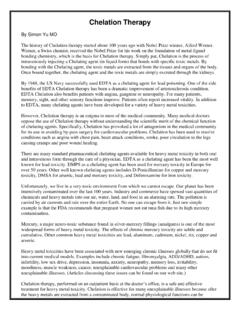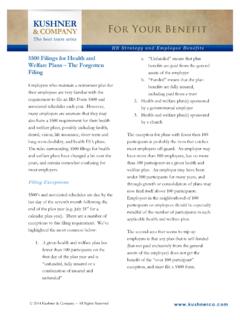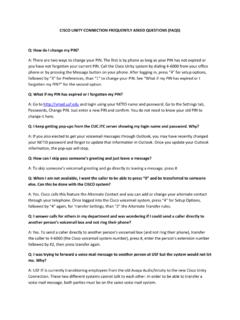Transcription of THE FEDERAL COURTS LAW REVIEW The Forgotten …
1 THE FEDERAL COURTS LAW REVIEW . Volume 7, Issue 1 2013. The Forgotten Pleading Hon. Amy St. Eve1 & Michael A. Zuckerman2. TABLE OF CONTENTS. INTRODUCTION .. 153 I. THE ANSWER GENERALLY .. 154 II. ADMISSIONS AND DENIALS .. 156 A. Denials .. 156 B. Admissions .. 157 III. DEFENSES .. 158 A. Rule 12(b) Defenses .. 159 B. Negative & Affirmative 160 1. The Legal Distinction .. 160 2. The Practical Differences .. 162 a. Requirement of Pleading .. 162 b. Pleading Standard .. 164 c. Method of Pre-Trial Attack .. 166 d.
2 Issue for the Jury .. 166 C. Defenses & Motion Practice .. 167 1. Negative Defenses .. 167 2. Affirmative Defenses .. 168 a. Summary Judgment .. 168 b. For the Plaintiff .. 168 c. For the Defendant .. 170 D. The Problem of Defenses .. 172 IV. COUNTERCLAIMS .. 174 1. The Honorable Amy St. Eve is a United States District Court Judge for the Northern District of Illinois. Judge St. Eve earned her , magna cum laude, from Cornell Law School, and her from Cornell University. She was appointed to the FEDERAL district court in 2002, at the age of 36.
3 Judge St. Eve is also an adjunct professor at Northwestern Law School. 2. Michael Zuckerman, a former law clerk to Judge St. Eve, is an associate at Jones Day in Chicago, Illinois. Mr. Zuckerman earned his , cum laude, from Cornell Law School, and his from Cornell University. Prior to clerking for Judge St. Eve, Mr. Zuckerman clerked for a FEDERAL appellate judge on the Sixth Circuit and a FEDERAL magistrate judge in the Eastern District of New York. The views set forth herein are the personal views of the authors and do not necessarily reflect those of the court or the law firm with which they are respectively associated.
4 2013] The Forgotten Pleading 153. CONCLUSION .. 175 INTRODUCTION. The Supreme Court's decisions in Twombly and Iqbal have brought renewed attention to the civil complaint. It is well established that a civil action is commenced by filing a complaint 3 and, until recently, FEDERAL COURTS would routinely permit claims to proceed beyond the pleading stage unless it appear[ed] beyond doubt that the plaintiff can prove no set of facts in support of his claim which would entitle him to relief. 4 But in a pair of decisions Bell Atlantic Corp.
5 V. Twombly5 (2007) and Ashcroft v. Iqbal6 (2009) the Supreme Court retired .. the no-set-of-facts test and replaced it with the plausibility Under this retooled test, as one court has called it,8 a complaint must contain sufficient factual matter, accepted as true, to state a claim to relief that is plausible on its face. 9. In the aftermath of Twombly and Iqbal, there has been a great deal of commentary, debate, and reflection about the plausibility standard and the civil One study reports that as of June 30, 2009, FEDERAL COURTS have cited Twombly nearly 24,000 times, making it the seventh most-cited case of all time.
6 11 That number has surely increased dramatically, and by our count, may now have reached over 66, Often absent from the recent discussion but lingering in the shadows is the civil answer. The answer can bring with it significant procedural advantages but is too often overlooked. In this Article, we seek to bring the answer back into focus. Rather than offer an exhaustive discussion of the answer, we will focus on some of its important aspects to suggest that mastery of the answer is fundamental to achieving success (and 3.)
7 FED. R. CIV. P. 3; see also Walker v. Armco Steel Corp., 446 740, 751 (1980). 4. Conley v. Gibson, 355 41, 45 46 (1957); see also Mattice v. Mem'l Hosp. of S. Bend, Ind., 249 682, 686 (7th Cir. 2001). 5. Bell Atl. Corp. v. Twombly, 550 544 (2007). 6. Ashcroft v. Iqbal, 556 662 (2009). 7. Id. at 670. 8. Killingsworth v. HSBC Bank Nevada, , 507 614, 618 (7th Cir. 2007). 9. Iqbal, 556 at 678 (citations omitted). 10. See, , Mark Herrmann et al., Plausible Denial: Should Congress Overrule Twombly and Iqbal, 158 U.
8 PA. L. REV. PENNUMBRA 141 (2009). Congress even jumped into the fray. In 2009, then-Senator Arlen Specter proposed a law, the Notice Pleading Restoration Act, which sought to overturn Twombly and Iqbal. See Hutchingson v. Metro. Gov't of Nashville and Davidson Cnty., 685 F. Supp. 2d 747, 751-52 ( Tenn. 2010); Jonah B. Belbach, Locking the Doors to Discovery? Assessing the Effects of Twombly and Iqbal on Access to Discovery, 121. YALE 2270, 2284 (2012). 11. See May We Plead the Court? Twombly, Iqbal, and the New' Practice of Pleading, 38 HOFSTRA L.
9 REV. 1191 (2010). 12. We calculate this number based on a search of citing references on Westlaw . September 5, 2012. 154 FEDERAL COURTS LAW REVIEW [Vol. 7. avoiding painful procedural traps) in FEDERAL court. Part I reviews the basics of the answer as a pleading. Parts II and III. focus respectively on two of the primary functions of the answer: to admit and deny allegations in the complaint, and to raise defenses. In Part II, we discuss how admissions and denials, though seemingly simple, are intricate and important.]
10 Part III then turns to the law of defenses, exploring the differences between Rule 12(b), negative, and affirmative defenses, and why those differences matter as both a legal and a practical matter. Part IV. briefly discusses counterclaims. I. THE ANSWER GENERALLY. An answer is a type of pleading through which a party responds to claims, asserts, defenses, and makes any claims of its It may only be filed in response to a complaint, counterclaim, cross-claim, or third- party Rule 7(a) enumerates four types of answers, each based on the procedural posture of the claim to which it responds.






